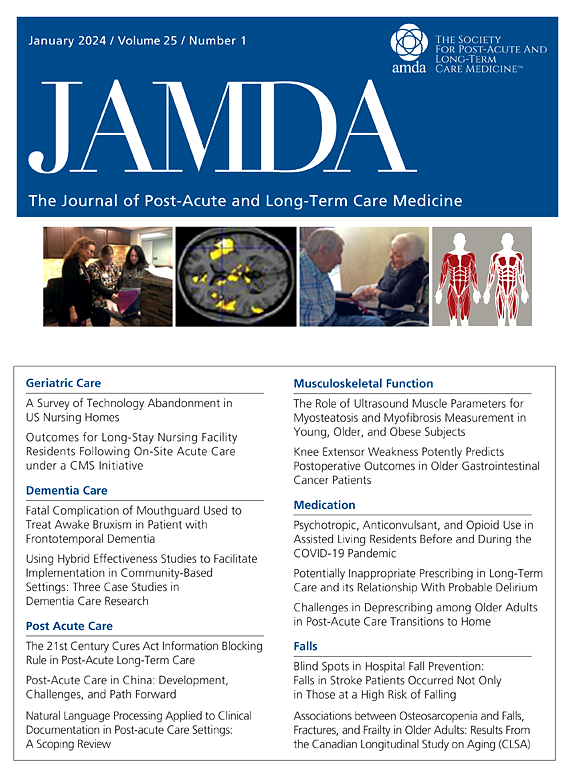Lifting Federal Visitation Restriction and COVID-19 Infections in Nursing Homes
IF 4.2
2区 医学
Q2 GERIATRICS & GERONTOLOGY
Journal of the American Medical Directors Association
Pub Date : 2025-05-28
DOI:10.1016/j.jamda.2025.105682
引用次数: 0
Abstract
Objectives
Early in the COVID-19 pandemic, the Centers for Medicare and Medicaid Services (CMS) recommended restricting visitors from entering nursing homes as a precaution. The restriction was lifted on September 17, 2020. This study examines whether COVID-19 infection rates among residents increased after the lifting of the federal restriction, providing indirect evidence on the impact of introducing visitation restrictions.
Design
We used a difference-in-differences event-study framework to compare changes in nursing home COVID-19 infection rates in the 4 weeks before (August 23, 2020–September 13, 2020) vs. 8 weeks after (October 4, 2020–November 22, 2020) the lifting of the federal visitation restriction.
Setting and Participants
The study cohort included 4823 nursing homes in the 19 treatment states that never had state-level visitation bans and 1654 nursing homes in the 8 control states that implemented state bans but lifted their bans by August 2020. The control group theoretically had the ability to allow visitation before the lifting of the federal restriction.
Methods
Our primary outcomes were weekly nursing home COVID-19 infection rates among residents and community-adjusted resident infection rates. The policy change was the lifting of federal visitation restriction on September 17, 2020. All analyses control for other facility characteristics that may impact COVID-19 spread in nursing homes.
Results
Nursing home infection rates closely mirrored the trend in community COVID-19 infections. Our regression analyses found no statistically significant increase in nursing home infection rates (ß = 2.4; 95% CI, −6.4 to 11.2) or the community-adjusted infection rates (ß = −5.2; 95% CI, −10.9 to 0.5) associated with the lifting of the federal restriction.
Conclusions and Implications
Lifting the federal visitation restriction had a negligible impact on nursing home infection rates. Policymakers and nursing home administrators should only consider implementing visitation restrictions under extreme circumstances.
取消联邦探视限制和疗养院中的COVID-19感染。
目的:在COVID-19大流行早期,医疗保险和医疗补助服务中心(CMS)建议限制访客进入养老院作为预防措施。这一限制于2020年9月17日取消。这项研究调查了取消联邦限制后居民的COVID-19感染率是否增加,为引入探视限制的影响提供了间接证据。设计:我们使用差异中的差异事件研究框架来比较取消联邦探视限制前4周(2020年8月23日- 2020年9月13日)和后8周(2020年10月4日- 2020年11月22日)养老院COVID-19感染率的变化。环境和参与者:研究队列包括19个治疗州的4823家养老院,这些州从未有过州级探视禁令,以及8个控制州的1654家养老院,这些州实施了州禁令,但在2020年8月之前取消了禁令。理论上,在联邦限制解除之前,对照组有能力允许探视。方法:我们的主要结局是每周养老院居民COVID-19感染率和社区调整居民感染率。政策变化是在2020年9月17日取消联邦访问限制。所有分析都控制了可能影响COVID-19在养老院传播的其他设施特征。结果:养老院感染率与社区COVID-19感染趋势基本一致。我们的回归分析发现,养老院感染率没有统计学上的显著增加(ß = 2.4;95% CI, -6.4至11.2)或社区调整感染率(ß = -5.2;95% CI, -10.9至0.5)与解除联邦限制有关。结论和意义:解除联邦探视限制对养老院感染率的影响可以忽略不计。政策制定者和养老院管理者应该只考虑在极端情况下实施探视限制。
本文章由计算机程序翻译,如有差异,请以英文原文为准。
求助全文
约1分钟内获得全文
求助全文
来源期刊
CiteScore
11.10
自引率
6.60%
发文量
472
审稿时长
44 days
期刊介绍:
JAMDA, the official journal of AMDA - The Society for Post-Acute and Long-Term Care Medicine, is a leading peer-reviewed publication that offers practical information and research geared towards healthcare professionals in the post-acute and long-term care fields. It is also a valuable resource for policy-makers, organizational leaders, educators, and advocates.
The journal provides essential information for various healthcare professionals such as medical directors, attending physicians, nurses, consultant pharmacists, geriatric psychiatrists, nurse practitioners, physician assistants, physical and occupational therapists, social workers, and others involved in providing, overseeing, and promoting quality

 求助内容:
求助内容: 应助结果提醒方式:
应助结果提醒方式:


